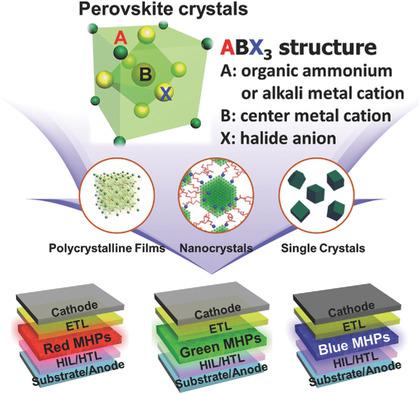当前位置:
X-MOL 学术
›
Small Methods
›
论文详情
Our official English website, www.x-mol.net, welcomes your feedback! (Note: you will need to create a separate account there.)
Metal Halide Perovskites: From Crystal Formations to Light‐Emitting‐Diode Applications
Small Methods ( IF 12.4 ) Pub Date : 2018-07-30 , DOI: 10.1002/smtd.201800093 Young-Hoon Kim 1 , Sungjin Kim 1 , Seung Hyeon Jo 1 , Tae-Woo Lee 1
Small Methods ( IF 12.4 ) Pub Date : 2018-07-30 , DOI: 10.1002/smtd.201800093 Young-Hoon Kim 1 , Sungjin Kim 1 , Seung Hyeon Jo 1 , Tae-Woo Lee 1
Affiliation

|
Metal halide perovskites (MHPs) are promising light emitters because they have high color purity, high charge‐carrier mobility, comparable energy levels with organic semiconductors, and the possibility of diverse crystal forms and various crystal formation methods. Since the first report of MHP light‐emitting diodes (PeLEDs) in 2014, many researchers have devoted efforts to increase the luminescence efficiencies of MHPs in various crystal forms, and achieved dramatically improved photoluminescence quantum efficiency of >90% in MHP emitters and external quantum efficiency of ≈14.36% in PeLEDs. Here, the recent progress regarding PeLEDs is reviewed by categorizing MHPs into three types: polycrystalline bulk films, colloidal nanocrystals, and single crystals. The main focus is on photophysical properties, crystallization methods, and mechanisms of various crystal formation, and applications to PeLEDs. Future research directions are also suggested and an outlook for MHP emitters and PeLEDs is given.
中文翻译:

钙钛矿金属卤化物:从晶体形成到发光二极管的应用
金属卤化物钙钛矿(MHP)是有前途的发光体,因为它们具有高色纯度,高电荷载流子迁移率,可与有机半导体媲美的能级以及多种晶体形式和各种晶体形成方法的可能性。自2014年首次发表MHP发光二极管(PeLED)以来,许多研究人员致力于提高各种晶型MHP的发光效率,并实现了MHP发射器和外部量子中> 90%的光致发光量子效率的显着提高。 PeLED中的效率约为14.36%。在这里,通过将MHP分为三种类型来回顾有关PeLED的最新进展:多晶体膜,胶体纳米晶体和单晶。主要关注光物理性质,结晶方法,以及各种晶体形成的机理,以及在PeLED中的应用。还提出了未来的研究方向,并给出了MHP发光体和PeLED的前景。
更新日期:2018-07-30
中文翻译:

钙钛矿金属卤化物:从晶体形成到发光二极管的应用
金属卤化物钙钛矿(MHP)是有前途的发光体,因为它们具有高色纯度,高电荷载流子迁移率,可与有机半导体媲美的能级以及多种晶体形式和各种晶体形成方法的可能性。自2014年首次发表MHP发光二极管(PeLED)以来,许多研究人员致力于提高各种晶型MHP的发光效率,并实现了MHP发射器和外部量子中> 90%的光致发光量子效率的显着提高。 PeLED中的效率约为14.36%。在这里,通过将MHP分为三种类型来回顾有关PeLED的最新进展:多晶体膜,胶体纳米晶体和单晶。主要关注光物理性质,结晶方法,以及各种晶体形成的机理,以及在PeLED中的应用。还提出了未来的研究方向,并给出了MHP发光体和PeLED的前景。



























 京公网安备 11010802027423号
京公网安备 11010802027423号